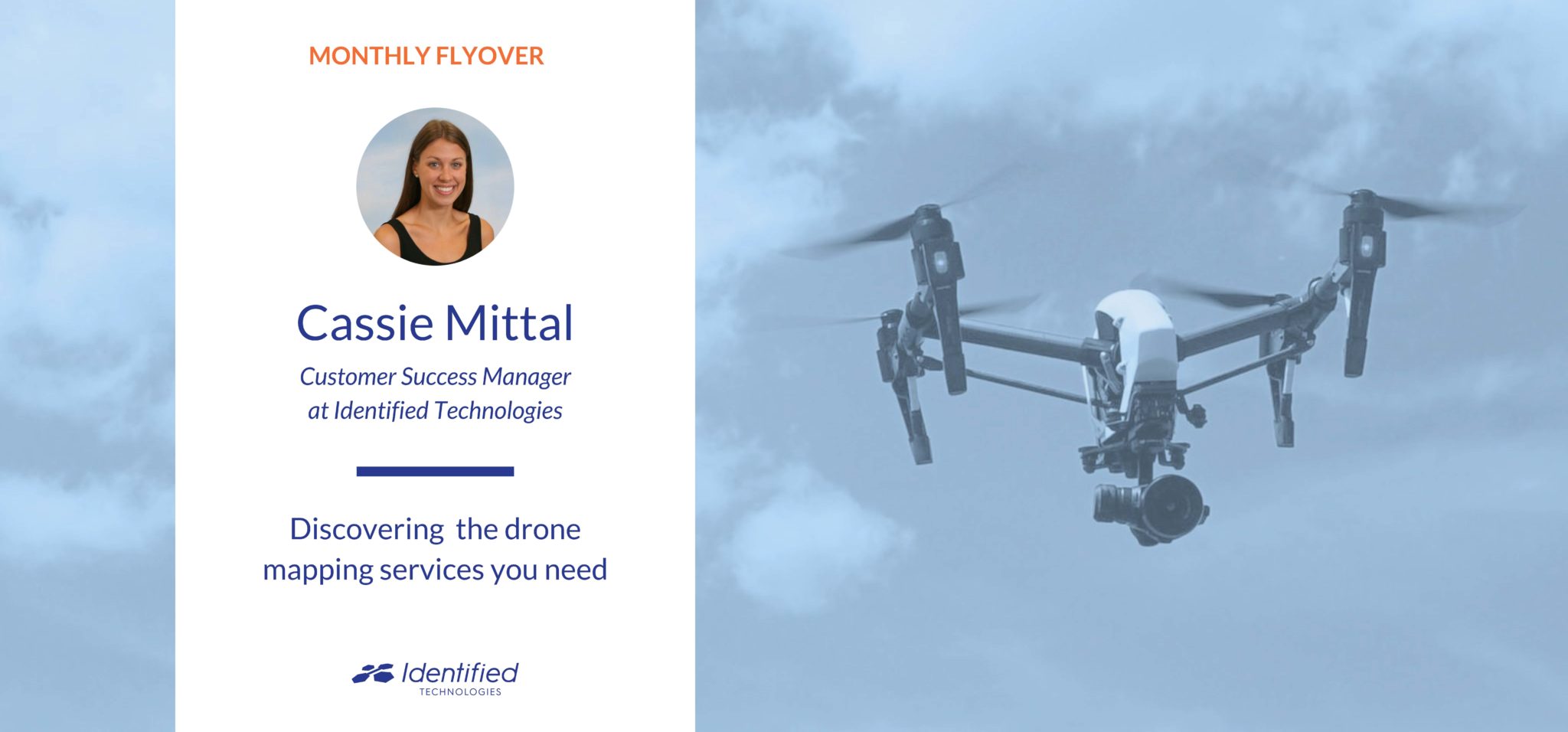28 Sep Monthly Flyover: Discovering the Drone Mapping Services You Need

Cassie Mittal, the Customer Success Manager at Identified Technologies, sat down with me to speak candidly about her role, the customer success journey at a drone mapping company, and her opinions on all of it. After spending her entire career working with customers, she discloses everything you need to know about the relationship you need to have with a drone mapping provider.
While reading this interview, you’ll learn the important questions to ask when exploring different drone mapping companies, understanding their approach to customer success, how to spot red flags that will make you walk away, and more.
Let’s dive into the questions:
Q: Tell us a little bit about your position at Identified Technologies, what are your main responsibilities?
A: I am the Customer Success Manager. In my role, I walk the customer through their drone mapping journey. I help with FAA Part 107 training and education, get them up and running with our drone mapping software, and keep them up-to-date with any feature changes. Additionally, I ensure they’re receiving maximum value from drone data and applying it back to their company.
Q: Out of all of those, what would you say is the most crucial?
A: Customizing and setting up their own drone mapping roadmap. There is no one-size-fits-all, I have to get to know each specific company. I’ll learn about the solution they were using before to get data and their company workflow so they have a seamless transition.
Another crucial role I play is helping them have, what I call, the ‘wow’ moment. This is when the customer sees with their own eyes the value drone data adds to their company.
Q: Walk me through the onboarding process.
A: I have what we call a ‘kickoff call’ with the customer to get a game plan together and set out some initial goals. From there, again, it’s a customized roadmap. After the kickoff call, I’ll draft a personalized customer-journey. It’s a checklist we follow to make sure there’s progress being made toward the goals we set out with the customer.
Once the customer is set and ready to go, I’ll still check in each quarter just in case their goals evolve or change.
Q: Can you share your opinion on Part 107 and the training necessary for it?
A: I think the Part 107 regulation passed by the FAA is fantastic, it allows anyone to fly drones commercially. It can be overwhelming, but if you’re working with a good support team, they’ll be there through every step of the way.
The customer is able to attain their Part 107 license but can also lean on their drone mapping team to check airspace, get waivers, and look for temporary flight restrictions in their area.
Additionally, the customer knows their job site the best. There’s nothing like going out on site when the weather is nice and they have an hour to spare because they have to submit quantities later on in the week. If they didn’t have Part 107, that convenience wouldn’t be there, which is where the value lies.
Q: Talk about the relationship you try to attain with customers once they’re set and ready to go.
A: It’s different for each customer. Anytime I’m on the phone with a customer, even if it’s them letting me know they’re about to upload a flight, I try to use that conversation as a touchpoint. I’ll ask them questions like ‘So what’s going on at your site that you just flew today?’ and ‘Why did you fly today?’ I like to personalize each relationship I have so they’re comfortable talking to me about any issues that could come up.
Q: Walk me through the problem-solving process/approach you take to help customers through whatever issue they may be having.
A: We have pretty beefy FAQ, help guides, and tutorials. We’re quick to solve a lot of the issues because our team is right here.
Q: Are there other members of the company that help you do your job and what role do they play for the entire customer success process?
A: Oh, every single person in the company. And I can’t stress this enough, every single person in the company is responsible for customer success. From sales to our tech team and developers — they are they thinking about our users and making the tools and the features intuitive and easy to use and giving our customers control to manage and analyze their data.
When it comes to flight training, our VP of Aviation, Jon Little is a guru. He checks the customer’s airspace and gets waivers when they’re needed. He’s a huge help with Part 107 training and is an ATP pilot, not just a UAV pilot. He knows all the things the customer needs for the exam and makes sure they’re understanding the information they’re given. Additionally, after training, if the customer needs help with any flight, Jon’s on it and will be on site with them.
Q: What should the customer be prepared for when they sign on to a drone mapping program and what questions they should be asking?
A: Most of the time, questions, and the pushback are all related to flying the drone. How long do I have to study for the 107 test? How much does it cost? What if I don’t pass? How long does the battery last on the drone? How much area can I cover with one battery?
Those questions aren’t the most important. Anyone in the market for a drone mapping solution should be asking data related questions like, what is the accuracy? What control do I have over my site data? What help will I get with converting data? They should be asking questions that give them answers to the big problems they’re solving like budgets and project bids.
Q: What is the most important thing to understand when shopping for a drone mapping solution?
A: I’m definitely biased with this response, but it’s the support and success the customer receives when signing on with a solution. Many companies are very similar in the product they offer, however, there are always differences when it comes to support.
Let’s say the customer has a question or is in a situation, a dedicated drone mapping success team is there to give them answers immediately. Many companies have ticketing or email systems, so the customer can’t contact them directly and could take a while to get an answer.
Q: What are some red flags and deal-breakers when shopping for a commercial drone mapping solution?
A: Off the top of my head, I would say unclear data privacy and control. By this, I mean how data and information are shared with other people and how it’s used when uploaded to a cloud-based portal.
It’s about the access the customers have to their data. Can they download it and do other things with it outside of the software? Or after that closes, do they own it? Who does?
Q: What makes the role of a customer success manager unique at a drone mapping company?
A: Being in touch with the user. Since we’re in a cutting-edge industry, we’re constantly evolving from customer feedback. With that, we develop new products or tweak current features to stay on top of it with our customers.
Q: What is the impact of a dedicated customer success team for the customer?
A: It’s a not just onboarding, it’s a partnership through the entire life of the customer’s contract. A dedicated customer success team will always make sure the customer has the latest and greatest hardware and software the company has to offer.
Q: What advice would you give to someone new to drone mapping and shopping for a drone mapping provider?
A: Don’t focus so much on the drone model that’s offered or how exactly the flying operations will go, that is very replaceable and will always be changing. Focus more on the companies, their initiatives, their roadmap, how they work with their customers, and who’s available for you to help you. It will pay off long term.
Q: If a drone mapping company doesn’t touch on customer success during initial conversations, should the customer be worried?
A: I would! It’s saying the company either doesn’t have time, or put their customers first, or want their customers to be a part of development. Whether you know everything about drones, flying, processing, and analyzing data, there’s going be some time in your journey that you’re going to have questions or suggestions. A drone mapping team isn’t successful without a focus on customer success — they help us make it happen.
Related Content: How to Start Drone Mapping Operations After FAA Part 107: Step-by-Step Guide



No Comments